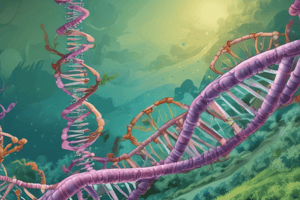Podcast
Questions and Answers
What determines the size of DNA fragments generated by restriction enzymes?
What determines the size of DNA fragments generated by restriction enzymes?
- The bacterium from which the enzyme is purified
- The temperature at which the enzyme operates
- The enzyme's efficiency
- The frequency of occurrence of the recognition sequence (correct)
What is the purpose of restriction endonucleases in genetic engineering?
What is the purpose of restriction endonucleases in genetic engineering?
- To inhibit DNA replication
- To amplify DNA sequences
- To synthesize new DNA strands
- To cut specific sequences of DNA (correct)
Which part of the restriction enzyme nomenclature comes from the specific name of the organism?
Which part of the restriction enzyme nomenclature comes from the specific name of the organism?
- Presence of extrachromosomal elements
- First two letters of the specific name (correct)
- Strain indicator
- First letter of the generic name
What is illustrated by the binding of the restriction enzyme BamHI to the DNA helix in Fig. 4.1?
What is illustrated by the binding of the restriction enzyme BamHI to the DNA helix in Fig. 4.1?
Which enzyme is derived from Escherichia coli?
Which enzyme is derived from Escherichia coli?
How many base pairs are the most common recognition sequences for restriction enzymes?
How many base pairs are the most common recognition sequences for restriction enzymes?
How does the enzyme BamHI facilitate the hydrolysis of the phosphodiester linkages in DNA?
How does the enzyme BamHI facilitate the hydrolysis of the phosphodiester linkages in DNA?
Which molecular modeling software was used to generate the figure illustrating BamHI binding?
Which molecular modeling software was used to generate the figure illustrating BamHI binding?
What additional descriptors may be added to the name of a restriction enzyme?
What additional descriptors may be added to the name of a restriction enzyme?
What characteristic of restriction endonucleases gives them value in genetic engineering?
What characteristic of restriction endonucleases gives them value in genetic engineering?
Flashcards are hidden until you start studying




